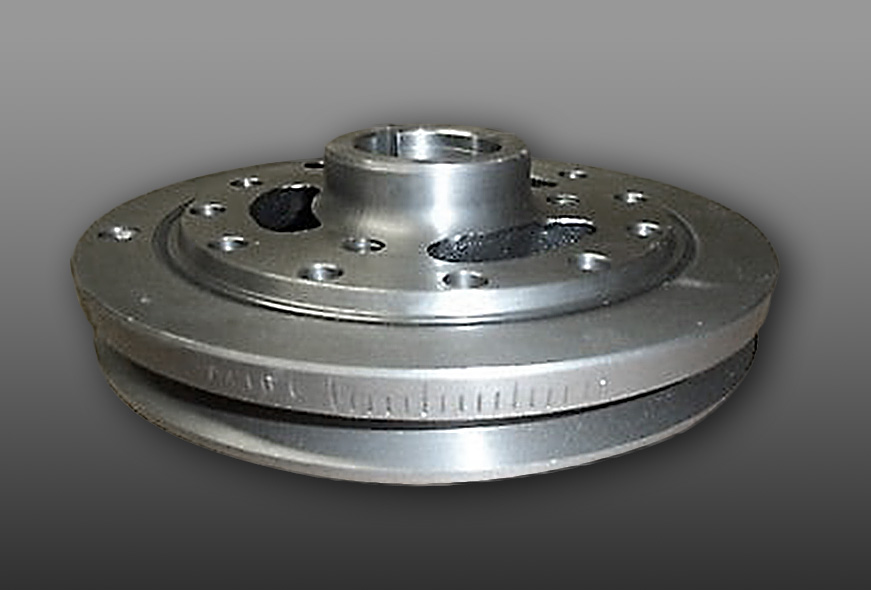Q.
I have a 65 t-bird with a 390 and I just changed over to electronic ignition. It runs great and starts right up. No pinging or missing. I want to make sure the timing is right but I cannot see a timing mark on the balancer. I found the indicator but no mark. Is there any other way to check the timing to make sure everything is right on? I can’t check dwell because there is no longer a separate coil.
A.
The timing marks can be tough to locate on the Ford 390’s of that era, although I assure you the marks are there.
You must establish a timing mark on the Harmonic Balancer in order to properly time the engine. Sometimes the factory mark is not pronounced or filled with rust, grease, dirt, etc…
Clean, wire brush, sand, or whatever it takes to properly locate the timing mark.
It is possible to apply a new timing mark, but you would need to bring the engine to absolute Top Dead Center (TDC) on the compression stroke and mark the harmonic at the indicator. But this is really a last resort.
You are correct, there are no points to adjust anymore and therefore no dwell to set… that’s a good thing.
Wrench Safe, Mark

Being I haven't seen anyone yet mention this -I will . . . On just about any domestic vehicle engine of this age range, the vulcanized rubber joint between the hub and vibration dampener outer counterweight become un-bonded from age, heat, oil, grease, and vibration, resulting in the outer section to rotate from it's original reference location. This is many times the reason for timing marks being far from where they should be. If that's the case, get a new vibration dampner!
I’m not saying this is the case but if your timing marks have moved and you re-establish the marks by whichever method you choose, you still can not rely on these “new” marks. Remember, these marks moved due to an issue and until that issue is resolved, they may (or may not) continue to move.
I bought a ‘73 Ford LTD with a 400 4bbl stock. I don’t remember if it was a Cleveland or a modified. The points would close like clockwork every 3,000 miles. Had to keep a screwdriver & feeler gauge in the glove compartment just because. Remember jumping the solenoid to advance the engine?
Has anyone put a 61 f100 in ivory on a more modern frame?
Yes, look up videos on how to use a Vacuum Gauge to set timing it can also be used to adjust Carburetors. Vacuum Gauges can also be used to troubleshoot engine issues especially on older models.
TDC is TDC it can be at TDC on the compression stroke or TDC at the end of the exhaust stroke. Doesn't matter, the piston is at TDC when the timing mark is at TDC. If the outer ring on the balancer has moved, the TDC mark will be in the wrong place. On older engines, it is a good idea to find TDC. To find absolute TDC, pull all of the spark plugs. Rig a piston stop through the spark plug hole on #1. Rotate the engine by hand slowly until you contact the stop. Mark the harmonic balancer at the pointer. Rotate the engine in the opposite direction slowly by hand until you contact the stop. Mark the balancer again. Split the short distance between the 2 marks. This is absolute TDC.
The best way to set the timing is by using a vacuum gauge and setting it for max vacuum.
A caveat for point replacement systems. If they are installed in a fresh, rebuilt, and equipped with a new point mounting plate distributor, they are as wonderful as you imagine. If they are installed in an original, high mileage distributor, with inherent slop and play from normal use and age, they will give performance problems that are unpleasant, and difficult to diagnose and correct. Start with a fresh distributor and avoid potential gremlins. Fred Warren
Beware the MSD integral electronic billet distributor for the FE engines. Mine failed intermittently over several months with less than 5K miles on it. MSD refused to back it up. I ended up using an Accel billet distributor as an electronic trigger for an MSD 5A box I already had. This works great.
I had the same problem with a 62 Tbird. What I did was jack up the front of the car, install 2 jack stands under frame, with the engine running and safety glasses on, I crawled under and wire brushed the crank pulley. I know this doesn't sound safe but it went very well plus there is easier access to clean the harmonic balancer under the car.